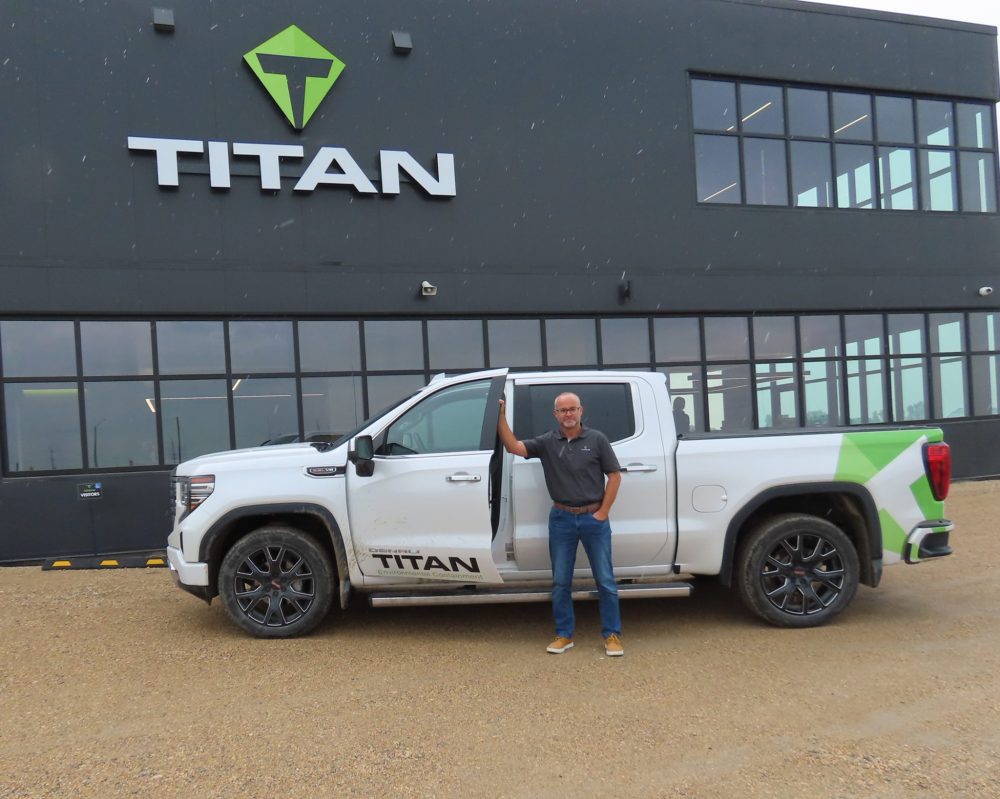Titan Environmental on way to being a giant of industry
Advertisement
Titan Environmental at Ile des Chenes is no longer the tiny company of four men and a truck it was when it was started in a Grande Pointe garage, nearly 20 years ago.
Today, the company, which has just moved its corporate headquarters to a new location in Ile des Chenes, has grown to seven locations in Canada, and one in the United States.
Titan President Juice Lambert says while they started in agriculture, providing geomembrane linings for hog lagoons, today their company’s expertise and high quality geosynthetics solutions are strongly focused on the mining industry.

Those lagoon lining projects, although smaller in scale than the company would soon become known for, presented certain challenges that shaped this growing company. Titan helped hog producing clients to reduce the risk of contaminating ground water, while protecting the environment as cost effectively as possible.
Those early lagoon projects provided a blueprint for the company’s rapid growth and its mission to do more than help manage environmental impact by helping to improve how that management was done.
Titan’s proven geosynthetics and specialty engineering solutions are designed to extend the life of vital infrastructure, while protecting precious natural resources.
Today, Titan operates in Canada and the United States, and supports environmental projects in several other countries as North America’s fastest growing geosynthetics supplier, fabricator, and installer.
Titan products are used in civil infrastructure, water and waste management, mining, oil and gas, hydroelectric and agriculture, as well as sports and recreation.
Titan Environmental is no longer known as “the liner guys”, who just supply and install geomembranes.
Lambert joined the company in 2011, five years after it had its beginnings in a garage in Grande Pointe. At that time, he was brought in to establish and expand Titan’s product supply division to diversify the business and was employee number five at the office, where there are now 47 people.
The move to a new location, less than a kilometre from their former home, is a welcome one, he says, for at the previous location they were bursting at the seams.
The Ile des Chenes location is company headquarters with offices in Regina, Leduc, Calgary, Surrey, Burlington, Ottawa and Houston, Texas.
The company has been enjoying many years of rapid growth, with the Canadian company having 190 employees. At headquarters in Ile des Chenes, only four or five employees live in Winnipeg, Lambert explains. The rest come from all over, including St Pierre, Linden, Lorette, Ste Agathe, Niverville, St Adolphe, Steinbach, St Malo, Oakbank, and of course, Ile des Chenes.
Titan is a locally-owned company, with a number of employees owning a varying number of shares along with majority shareholders.
And though the company has gone from ‘garage to global’, many of the projects have had a significant impact on the Southeast, and are continuing to do so, especially in the agriculture sector.
Titan’s geomembrane liners allowed for a tremendous expansion of the Manitoba hog industry, especially in areas where material for compacted clay liners was not available. All lagoons need liners, Lambert explains, and where there isn’t sufficient clay content available, that’s where geosynthetics come in.
“We lined a lot of lagoons in Southern Manitoba.”
But Titan’s impact on helping to preserve the environment has gone a long way beyond safer manure storage; geosynthetics provided by the company adds life to other infrastructures, as well.
From agricultural lining work, Titan moved on to servicing municipal infrastructure projects, such as lagoons, landfills and roads. Municipalities have been using geosynthetics for erosion control purposes and road building improvements.
One such product includes Geocell, a product that has been available for more than 25 years, Lambert says. It consists of honeycomb-shaped cells filled with stone that are confined, allowing for heavy machinery to cross creek beds without creating a lot of ruts.
The material is also used for erosion control and as a base for roadways, railways and retaining walls.
The Seine Rat Roseau River Watershed District has used Geocell in a number of projects in the Southeast, and it has been a great way of allowing farmers to access all parts of their fields, crossing creeks, rather than using municipal roads to get from one field to another.
